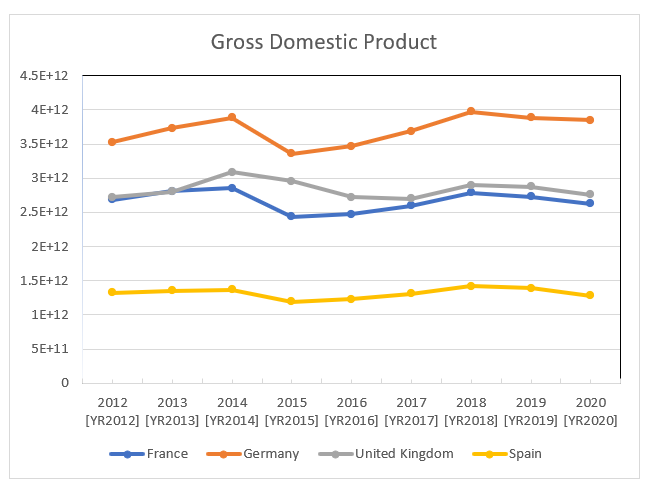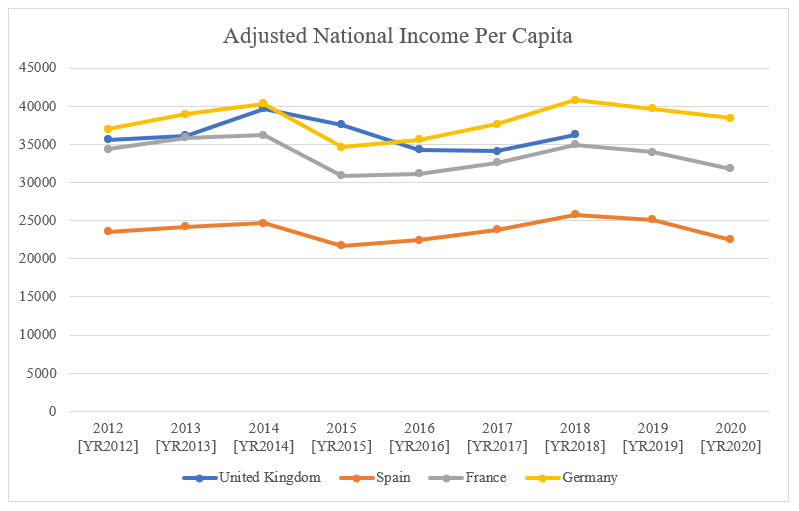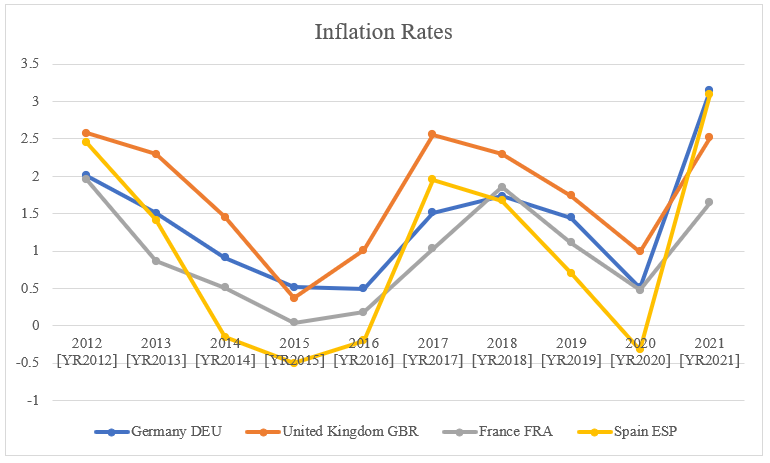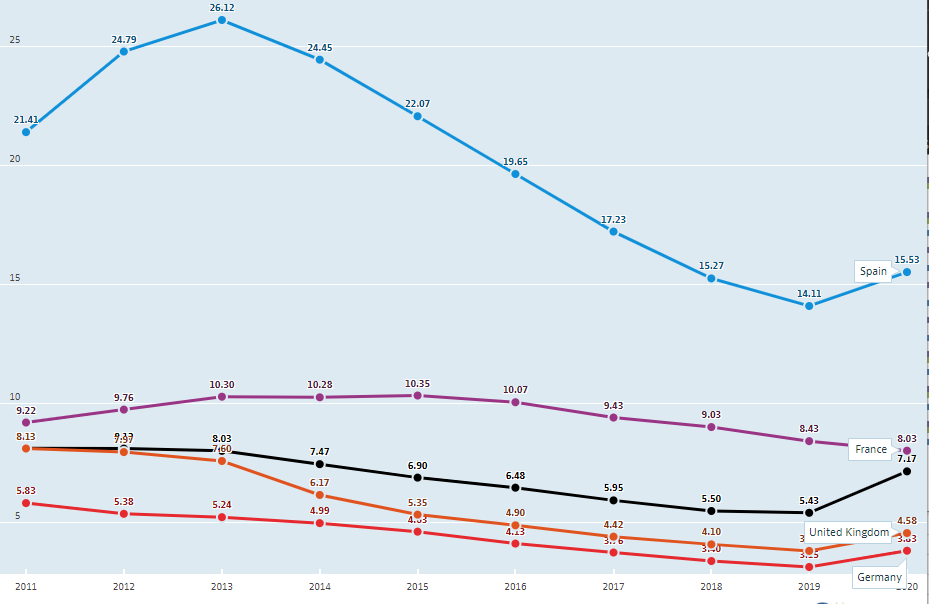Introduction
This report aims to analyze the economic progress of four European countries: France, the United Kingdom, Germany, and Spain. These four countries are similar in that they are all first-world countries and can all be classified as high-income economies. This report will analyze economic trends in the four countries over the last ten years, from 2012 to 2021. The assessment of economic performance will employ temporal analysis of key economic indicators such as unemployment rates, inflation, gross domestic product (GDP), and gross domestic product per capita. The assessment should provide valuable insight into whether the four countries meet the goals of promoting economic growth, lowering unemployment levels, and maintaining low and stable prices for goods.
Country Background
Europe is home to some of the world’s largest economies. Most European countries are part of the European Union, an intergovernmental organization in which countries agree to cooperate for economic growth. As such, members of the European Union must adopt policies to reduce barriers to international trade among member states. Additionally, citizens of the European Union may work or start businesses anywhere in the European Union and enjoy the same benefits as their counterparts. The European Union is arguably one of the most successful international trade organizations globally. With 27 countries making up the European Union, the bloc accounts for 15% of global trade, with exports from member states rivaling exports from China and exceeding those of the United States (European Union, 2022).
According to the Central Intelligence Agency (2022c), the United Kingdom left the European Union in 2016 following a popular referendum amid speculation that the move would result in poor foreign relations and poor economic performance. However, this has not been the case. The country of close to 68 million people is primarily an island nation, and most people are employed in the services sector, with the remainder in industry and agriculture. Germany is another European country bordering the Netherlands, Poland, and Denmark. The country has been a significant world power and was responsible for World War I and II and has the largest economy in Europe (Central Intelligence Agency, 2021). The German government increased the minimum wage to $9.79 in 2015. The country enjoys high budget and trade surpluses which means that the country’s economy is doing exceedingly well. The government recently embarked on a 15-billion-euro investment to stimulate private investment (Central Intelligence Agency, 2021). Nonetheless, this high-income country is one of the world’s leading economies, with a gross domestic product of over $4.2 trillion in 2020 (Central Intelligence Agency, 2021). The country is highly industrialized, and exports of machinery and natural resources like coal account for a large share of the country’s income. Spain was a powerful empire in the 16th and 17th centuries and even controlled the seas of England. The country, like Germany is also a member of the European Union and has adopted the Euro as currency in line with the European Monetary Union’s guidelines. The country faced a prolonged recession in 2008 following the global financial crisis that year (Criminal Intelligence Agency, 2022). As a result of the crisis, unemployment rates rose, more people relied on social benefits, and the government experienced declining revenues. France has a diversified economy that allows the country to remain economically stable despite global challenges. France’s economy faces challenges such as high expenditure with relatively low revenues, which has caused stagnation in GDP, with the country having a GDP of over $2.8 trillion in 2020 (Central Intelligence Agency, 2022).
Assessment of Economic Performance
This assessment includes an analysis of several economic growth indicators such as gross domestic product (GDP), adjusted national income per capita, unemployment rates, and inflation rates. It is worth noting that all four countries are high-income countries, according to The World Bank (2018). This means that these countries have a gross national income (GNI) per capita of over $12,696. Residents of these countries are typically wealthier than those from other countries worldwide and enjoy extensive social benefits coverage by their governments. Most countries in this category tend to be highly industrialized and have invested heavily in their infrastructure.
Gross Domestic Product
GDP is a valuable economic indicator because it measures all the value in goods and services that a country has produced during a period, typically one year. The graph below shows the GDP of four European countries from 2012 to 2020. The data indicates that the GDP of these countries has remained relatively high throughout this period, with significant dips happening towards the end of 2020 and in the period between 2014 and 2016. Peaks in GDP for all these countries are in the periods before either dip in GDP. The dip that occurred in 2020 was caused by government policies to reduce the spread of the coronavirus disease 2019, which reduced international movement and led to the temporary and permanent closure of many industries and businesses (). However, many countries are recovering from this shock to the economy. In Germany alone, the lockdown measures in the second half of 2020 were projected to produce 160 billion euros in government deficits. The situation is similar in other European countries where government expenditure to cushion people economically against the effects of the pandemic control measures increased while revenue decreased.

Figure 1. GDP of Four European Countries (World Bank, 2022)
National Income Per Capita
An assessment of national income per capita, also known as per capita income, gives a rough estimate of the gross how much the average person in the country of interest can reasonably expect to earn. Such data is beneficial in predicting the quality of life that people in those countries as higher per capita incomes indicate higher standards of living. There have been fluctuations in the per capita incomes of the four countries assessed here, as shown in Figure 2. Spain has the lowest national income per capita while Germany and the United Kingdom have the highest. Fluctuations are most notable as a general decline in the per capita incomes of all four countries between 2014 and 2016, although the United Kingdom’s decline was delayed. It is also worth noting that the four countries’ GDP and per capita incomes are parallel to each other, reflecting that a change in one is positively correlated with a change in the other. Both indicators are essentially proportional to each other, albeit loosely.

Figure 2. Adjusted National Income Per Capita (World Bank, 2022)
Inflation Rate
Inflation rates are usually an indication of a currency’s purchasing power. In this assessment, the consumer price index was used to measure the currency’s purchasing power. Figure 3 below shows that inflation rates fluctuated wildly but in rhythm with each other across all the four European countries assessed. Consistent with the declines in GDP and per capita income in the period between 2014 and 2015, there was a dip in inflation rates in most countries, with rapid deflation noted in 2015. Prices in Spain, for example, were lower in 2015 than they were in 2014, although this quickly changed in 2016 when inflation rates rapidly rose, reaching their peak in 2017 and 2018 before falling again in 2020. Inflation rates in all four countries are generally low, only reaching 3% in 2021 for Spain and Germany. This is probably a result of the reopening of the economies following the pandemic containment guidelines and the subsidization of economic relief packages offered by governments.

Figure 3. Inflation Rates of Four European Countries between 2012 and 2021 (World Bank, 2022)
Unemployment Rates
Unemployment rates have stagnated or declined in all four countries over the last ten years. Spain had the highest unemployment rate among all the countries analyzed, with a high of 26.12% in 2013, although this gradually declined to 14.11% in 2019. However, the unemployment rate again rose by over 1% in Spain in 2020, possibly because of pandemic control measures. This signals overreliance on social support systems by the government among Spaniards, which may make the government more likely to experience budgetary deficits. For the other countries, unemployment rates are relatively low, with Germany consistently having the lowest unemployment rates. All countries, however, experienced an increase in unemployment rates in 2020 as a result of pandemic control measures.

Figure 4. Unemployment Rates in Spain, France, United Kingdom, and Germany from 2011 to 2020 (OECD, 2020)
Conclusion and Judgement
This analysis aims to determine whether the countries analyzed are achieving macroeconomic goals of promoting economic growth, limiting unemployment, and keeping prices low and stable. Over the last ten years, it appears that the economies of each country have generally stagnated, neither growing rapidly nor contracting significantly. However, the absence of rapid growth does not mean that the countries under assessment are doing poorly economically. Their GDPs are significantly higher than those of other countries around the world. However, the countries still have the potential to grow, and more can be done to increase the rate of economic growth. Prices of commodities seem to be fluctuating periodically, but inflation rates generally remain low, meaning that commodities are largely affordable for citizens in these countries. Price stability coupled with high per capita incomes indicates that residents of the four countries are experiencing a high quality of life. While unemployment rates in the three countries are acceptably low, Spain lags. The government needs to address this issue to reduce its expenditure on social security services. Rodriquez-Planas (2013) explains that Spain’s unemployment problem stems from the high labor segmentation in the 1980s. She also blames the lack of permanent employment contracts in favor of short-term contracts due to the high unemployment rates. The government must rapidly address the segmentation of the labor market in the country.
References
Central Intelligence Agency. (2021). Germany – The World Factbook. Www.cia.gov. https://www.cia.gov/the-world-factbook/countries/germany/
Central Intelligence Agency. (2022a). France – The World Factbook. Www.cia.gov. https://www.cia.gov/the-world-factbook/countries/france/
Central Intelligence Agency. (2022b). Spain – The World Factbook. Www.cia.gov. https://www.cia.gov/the-world-factbook/countries/spain/#economy
Central Intelligence Agency. (2022c, May 10). The United Kingdom – The World Factbook. Www.cia.gov. https://www.cia.gov/the-world-factbook/countries/united-kingdom/
Clemens, M., Junker, Simon, & Pagenhardt, L. (2021). German economy only slowly emerging from the pandemic. Deutsches Institut Für Wirtschaftsforschung, 11, 276–280. https://doi.org/10.18723/diw_dwr:2021-37-2
European Union. (2022). Economy. European-Union.Europa. EU. https://european-union.europa.eu/principles-countries-history/key-facts-and-figures/economy_en
OECD. (2021). Unemployment – The unemployment rate – OECD Data. OECD. https://data.oecd.org/unemp/unemployment-rate.htm
Rodriquez-Planas, N. (2013). Spain’s Hard-Hit Labor Market. Blogs.worldbank.org. https://blogs.worldbank.org/jobs/spains-hard-hit-labor-market
The World Bank. (2018). World Bank Country and Lending Groups – World Bank Data Help Desk. Worldbank.org. https://datahelpdesk.worldbank.org/knowledgebase/articles/906519
World Bank. (2019). WDI – Home. Worldbank.org. https://data.worldbank.org/products/wdi
 write
write